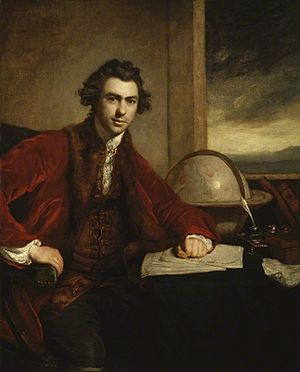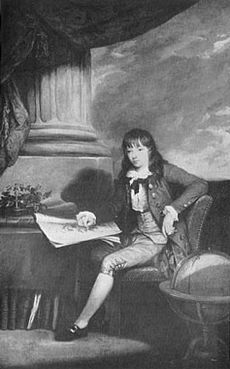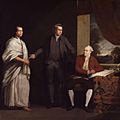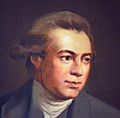Joseph Banks facts for kids
Quick facts for kids
Sir Joseph Banks, Bt
|
|
|---|---|

Joseph Banks, as painted by Sir Joshua Reynolds in 1773.
|
|
| Born | 13 February 1743 30 Argyll Street, London
|
| Died | 19 June 1820 (aged 75) London, England
|
| Nationality | British |
| Alma mater | University of Oxford |
| Known for | Endeavour voyage and exploration of Botany Bay |
| Scientific career | |
| Fields | Botany |
| Influences | Israel Lyons |
| Author abbrev. (botany) | Banks |
Sir Joseph Banks (born February 13, 1743 – died June 19, 1820) was a famous English naturalist and botanist. He loved studying plants and animals. He was also a big supporter of science.
Banks was the President of the Royal Society for many years, from 1778 to 1820. He was given the title of baronet in 1781. His huge collections of plants and other natural items were later given to the British Museum.
Joseph Banks joined Captain James Cook on his first big trip around the world. This journey lasted from 1768 to 1771. Banks had a lot of money from his family. This allowed him to hire his own team. They helped him collect, pack, and move all his amazing discoveries.
Banks found and collected many new plants. These included Eucalyptus, Acacia, Mimosa, and Banksia. More than 80 different kinds of plants are named after him!
Contents
Early Life and Education
Joseph Banks was born in Soho, London. His father, William Banks, was a wealthy country squire. He was also a member of the House of Commons. Joseph had a younger sister named Sarah Sophia. She was born in 1744.
Banks went to famous schools like Harrow School and Eton College. He also studied at Christ Church, Oxford University.
Exciting Explorations
Exploring Newfoundland and Labrador
In 1766, Banks became a member of the Royal Society. This was a big honor for a scientist. In the same year, he traveled to Newfoundland and Labrador. He went there to study the plants and animals. He became well-known for writing the first scientific descriptions of what he found there.
The Famous Endeavour Voyage
Banks was soon chosen for a special science trip. It was a joint mission by the Royal Navy and the Royal Society. They sailed to the South Pacific Ocean on a ship called HMS Endeavour. This trip happened from 1768 to 1771. It was the first of Captain James Cook's voyages to explore that area.
Banks brought a team of eight people with him. This included other naturalists and artists. They helped him collect and draw the new things they found. Sadly, only four of his team survived the long journey.
The Endeavour voyage first went to Brazil. There, Banks made the first scientific description of a plant called Bougainvillea. This plant is now very common in gardens. They also visited other parts of South America.
The ship then sailed to Tahiti. Here, the scientists watched the planet Venus pass in front of the Sun. This was a main goal of the mission. After Tahiti, they went to New Zealand. Then they sailed to the east coast of Australia. Captain Cook mapped the coastline there.
They landed at a place now called Botany Bay. They also stopped at the Endeavour River in Queensland. They stayed there for seven weeks. The ship needed repairs after hitting the Great Barrier Reef.
While in Australia, Banks and his team collected many new plants. They described almost 800 different kinds. An artist named Sydney Parkinson drew pictures of them all. These drawings were later published in a huge collection called Banks' Florilegium.
Banks returned to England on July 12, 1771. He became very famous right away because of his discoveries.
Joseph Banks in Popular Culture
Many things in Australia are named after Joseph Banks. For example, there is a special voting area called the Division of Banks. The plant species Banksia is also named after him.
His picture was even on the paper $5 Australian banknote. This was from 1967 until new money was made. In 1986, Australia honored him with his portrait on a postage stamp.
The Sir Joseph Banks Centre is in Horncastle, Lincolnshire. This building was restored to celebrate Banks' life. Horncastle is close to his family estate. The center has research areas and a garden with rare plants.
In 2016, a five-part TV show was made about Banks. It was called The Lost World of Joseph Banks. It explored his life and what he achieved.
Images for kids
-
Banks as painted by Benjamin West in 1773
-
Banks' house in Isleworth
-
Sir Joseph Banks (center), together with Omai (left) and Daniel Solander, painted by William Parry, circa 1775–76
-
In The great South Sea Caterpillar, transform'd into a Bath Butterfly (1795), James Gillray caricatured Banks's investiture with the Order of the Bath as a result of his expedition.
-
Portrait of Banks by Thomas Phillips (1810) National Portrait Gallery, London
-
This 1812 print depicts Banks as president of the Royal Society, wearing the insignia of the Order of the Bath.
-
Joseph Banks, detail of a painting by William Parry, 1775
-
Sir Joseph Banks by Anne Seymour Damer, British Library
See also
 In Spanish: Joseph Banks para niños
In Spanish: Joseph Banks para niños












